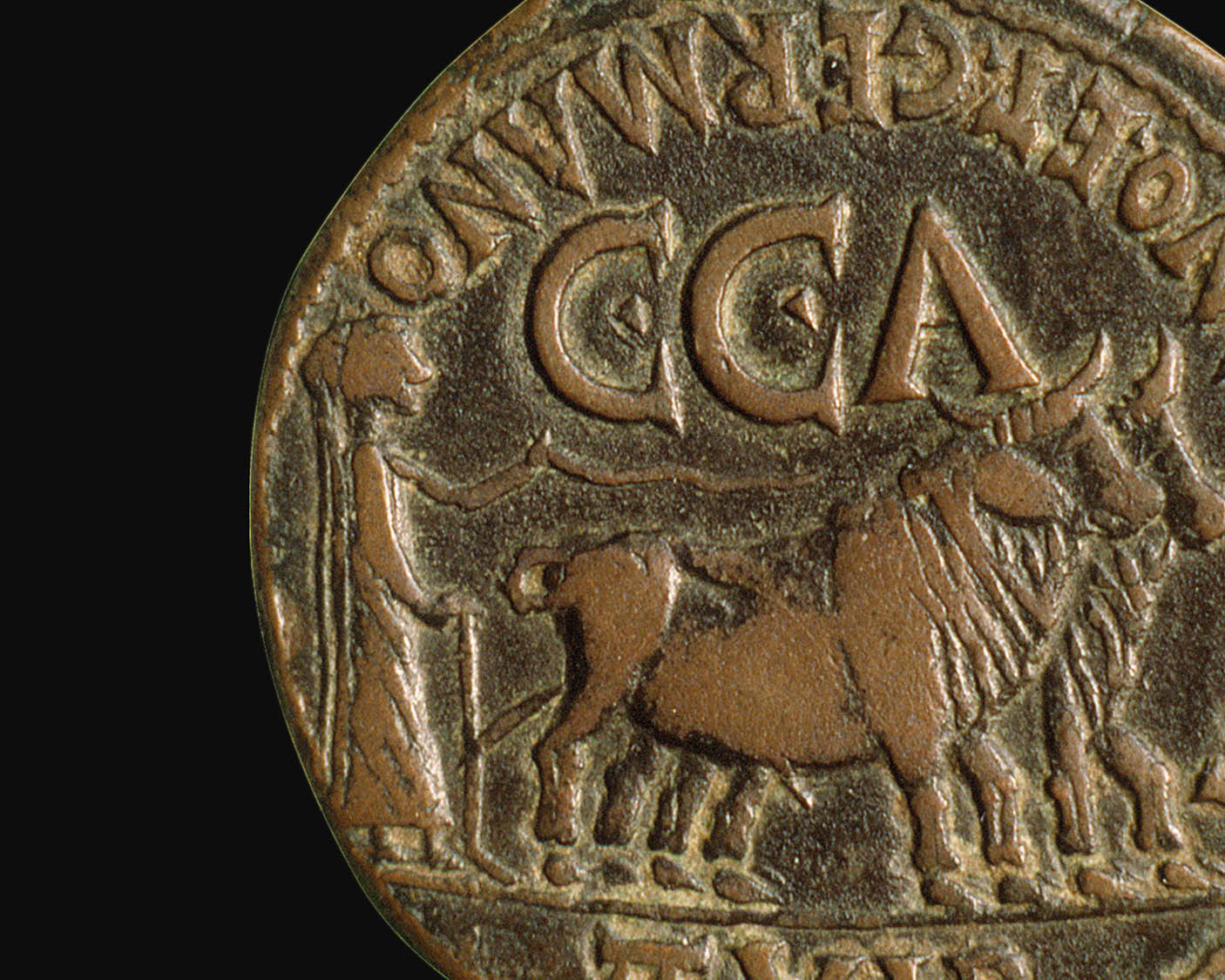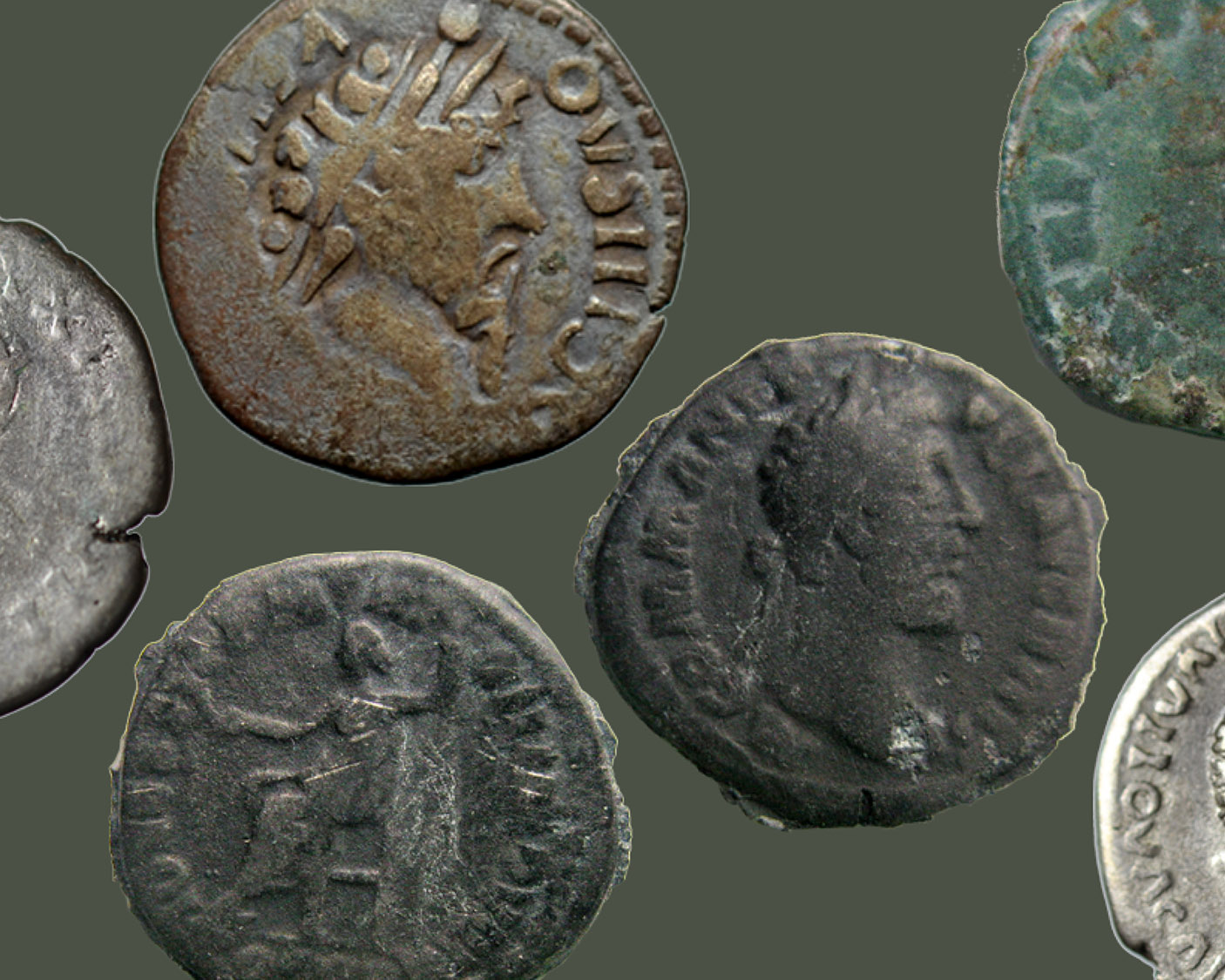Times of Hyperinflation
Hyperinflation
Coins always had a degree of intrinsic value. With paper banknotes, this constraint disappeared. These virtually free-of-costs monetary signs that could bear any officially decided value led to the decoupling of intrinsic and nominal values. The temptation for many modern states to exploit this opportunity proved too great to be resisted. As a result, the 20th and 21st centuries witnessed the most extreme situations of inflation ever recorded.
| Country | Month with Highest Inflation Rate | Highest Monthly Inflation Rate |
|---|---|---|
| Hungary | July 1946 | 41,900,000,000,000,000% |
| Zimbabwe | November 2008 | 79,600,000,000% |
| Yugoslavia | January 1994 | 313,000,000% |
| Germany | October 1923 | 29,500% |
| Greece | October 1944 | 13,800% |
| Taiwan (Republic of China) |
Germany 1922-23
The situation of hyperinflation in Germany in 1922-1923 remains the most famous price surge in history. It left its traces with the average German and a link is often established between the hyperinflation of 1923 and the accession to power of the Nazis in 1933. As in France, the outbreak of the First World War in 1914 had led to an immediate suspension of the German mark‘s convertibility into gold. Between 1914 and 1918, the paper money supply then increased four-fold while prices rose by 139%, as Germany had to buy its war supplies with precious metals, and print more money to keep paying its internal suppliers. After 1918, the US refused to forfeit the debt France, Italy, England and other allies had contracted during the war. Some of these countries had little choice then but to make sure Germany would fulfill in turn its own war damage commitments, set out in the Treaty of Versailles of 1919. This soon led Germany into an impossible economic situation. The Reichsbank printed ever more banknotes in order to lend them to the State to pay salaries, while industrial production collapsed as France and Belgium decided, in January 1923, to send their armies to occupy the productive Ruhr district in order to force Germany to resume its payments. Inflation reached its peak in October, 1923 at 29,500% (about 21% per day, compounded).

10 mark banknote, 1920 (ANS 0000.999.51362).

10,000 mark banknote, February 1923 (ANS 0000.999.51498).

1,000,000 mark banknote, July 1923 (ANS 0000.999.51537).

100,000,000 mark banknote, August 1923 (ANS 1984.52.591, gift of Russell Trenholme).
As denominations passed the million marks, words started to replace the zeros.

5,000,000,000 mark banknote, September 1923 (ANS 1992.117.6026, gift of Arthur Mintz).
In German, a milliard is equal to a billion in English.

200,000,000,000 mark banknote, October 1923 (ANS 1992.117.6040, gift of Arthur Mintz).

3,000,000,000,000 mark banknote, October 1923 (ANS 1944.112.12, gift of W. W. Woodside).
In German, a billion is equal to 1,000 billion in English.
Hjalmar Schacht, an economist, appointed in October 1923 to take charge of the monetary problems of Germany, rapidly became Governor of the German Central Bank, the Reichsbank, when its chairman died. Schacht spearheaded a set of monetary reforms. A new currency, the rentenmark, was created by official decree on October 15, 1923, to be effectively issued on November 15, 1923, by the Rentenbank. It was backed by land, industrial and residential property mortgaged by the bank. That currency was priced at a rate of 1 rentenmark to 1,000,000,000,000 mark and 4.2 to the US dollar. At the same time, the supply of the new currency was strictly controlled as the new monetary authorities committed not to fund the budget deficits and as such the Reichsbank stopped refinancing treasury bills. From 1924 onward, the German economy entered a non-inflationary expansion phase that would last until 1930.
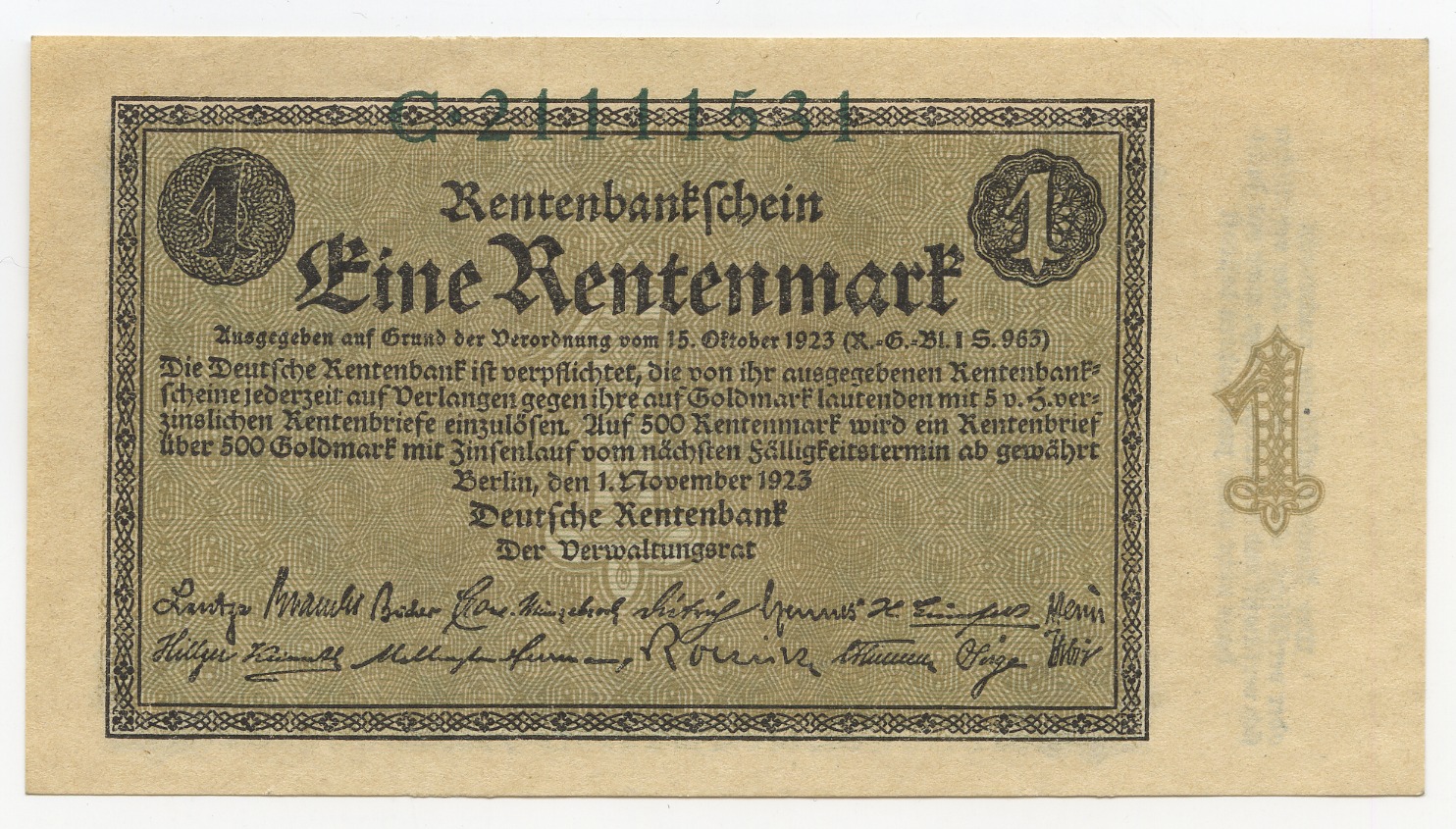
1 rentenmark banknote, November 1923 (ANS 0000.999.51651).
That new replacement currency was worth 1,000,000,000,000 mark.

100 reichsmark banknote, November 1924 (ANS 1992.117.6095, gift of Arthur Mintz).
A new reichsmark was finally reintroduced on August 31, 1924, at par with the rentenmark.
Hungary 1945-46
The Hungarian situation between August 1945 and July 1946 is the most brutal outburst of hyperinflation ever. The pengő, defined at 3,800 to the kilogram of gold, had been introduced January 1, 1927, as the national currency of Hungary. As elsewhere, the Second World War led to a steep increase of the money supply. The end of the war did not stop this as the Soviet occupation troops used their own currency, leaving the Hungarian government to handle its own depleted budget. 40% of the wealth of Hungary had been destroyed during the fighting in 1944-1945 and the country had to support the heavy costs extracted by Soviet occupation troops as well as war indemnities to the USSR, Czechoslovakia and Yugoslavia. As the pengő lost value, it was quickly replaced by the milpengő (1,000,000 pengő) and the b.-pengő (1,000,000,000,000 pengő) in order to cut the number of zeros. In January 1946, the adópengő (= tax pengő) was introduced as an accounting unit initially worth one pengő and supposed to remain stable while the pengő would depreciate. The rate of inflation culminated at 350% a day in the summer of 1946, as the adópengő reached 630 pengő on May 1st, 160,000 by June 1st and 2 × 1021 by July 31st! Since the adópengő purchasing power had depreciated as well, the compound inflation was even higher than implied by this exchange rate, and overall price levels increased by 2 × 1025 in 13 months. On August 1, 1946, the new forint was introduced, at a ratio of 1 for 2,000,000,000 adópengő and 4 × 1029 pengő, 11.74 forints being worth one dollar. This exchange rate effectively wiped out the value of the entire pengő money supply. The forint is still the Hungarian currency today, with an exchange rate of 292 to the euro and 223 to the dollar as of February 2, 2012.
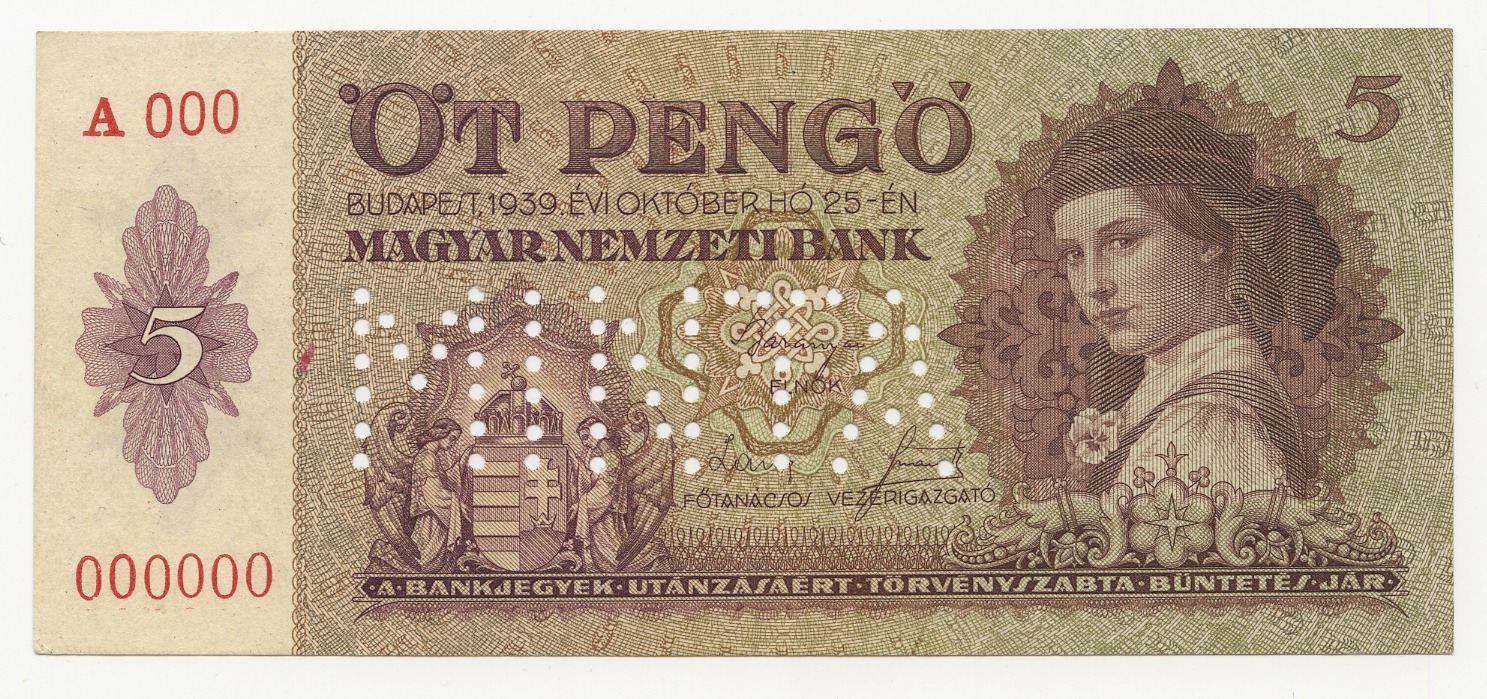
5 pengő banknote, October 1939 (ANS 1992.117.7064, gift of Arthur Mintz).

10,000 pengő banknote, July 1945 (ANS 1992.117.7081, gift of Arthur Mintz).
An interim government had been established in December 1944 while Nazi Germany and the USSR fought for the control of Hungary. It lasted until the elections of November 1945. The budget deficit, reconstruction tasks and lack of tax revenues led to increased reliance on printing ever more paper money.

100,000 pengő banknote, October 1945 (ANS 1953.39.116, gift of A. Z. Toth).

1,000,000 pengő banknote, November 1945 (ANS 0000.999.25423).
As in Germany, higher denominations witnessed the replacement of the zeros by words meaning million, billion, etc.

100,000,000 pengő banknote, March 1946 (ANS 1992.117.7090, gift of Arthur Mintz).
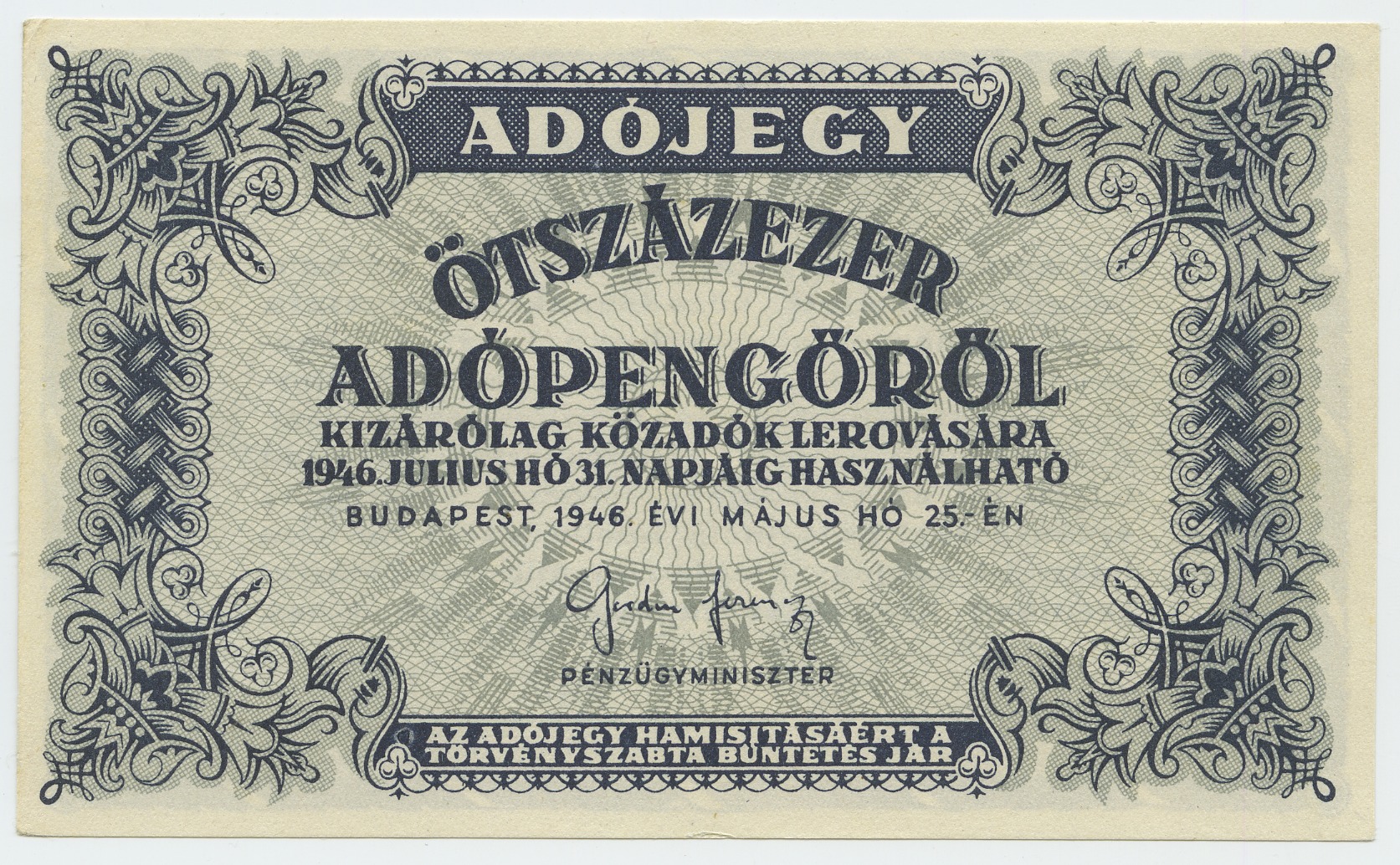
500,000 adópengő banknote, May 1946 (ANS 1992.117.7114, gift of Arthur Mintz).
The adópengő being worth approximately 1000 pengő at that time, this notional banknote was effectively worth 5 × 1011 pengő.

10,000 b.-pengő banknote, June 1946 (ANS 1992.117.7104, gift of Arthur Mintz).
The b.-pengő meaning 1012 pengő, this notional banknote was effectively worth 1016 or ten million billion pengő. Except for the “b” that added 12 zeros to the notional, this banknote is strictly identical to the 10,000 pengő banknote (see above), issued eleven months earlier.
image?
1 billion b.-pengő banknote, June 1946 (Loan of François Velde).
This notional banknote was effectively worth 1021 or a thousand billion billion pengő, and as such is the highest notional value currency ever printed.
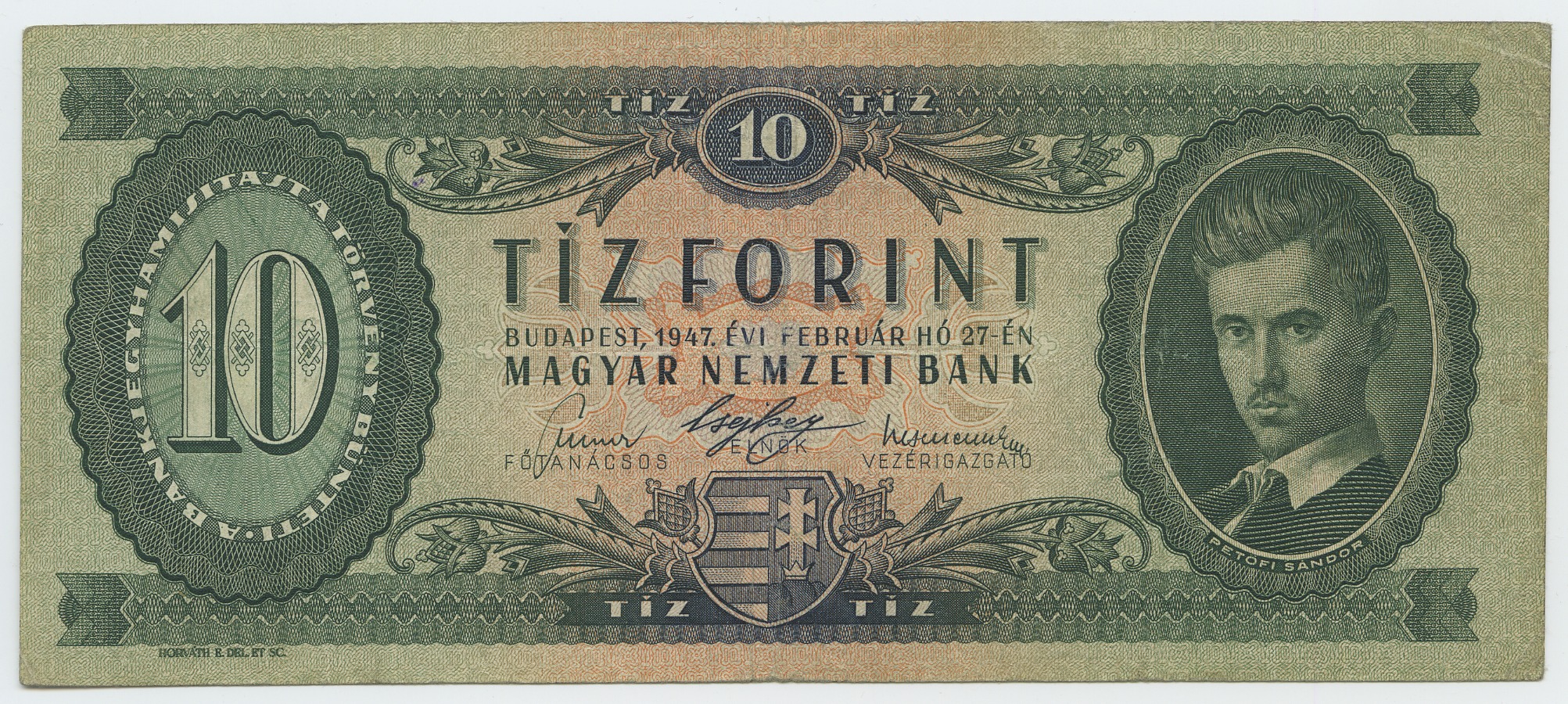
10 forint banknote, February 1947 (ANS 1992.117.7129, gift of Arthur Mintz).
The forint replaced the pengő, in August 1946, and eradicated inflation as a result of controlled paper money supply and fiscal reform.
Exhibition Parts
III. Rome: A Thousand Years of Inflation
IV. France: Inflation and Revolution



